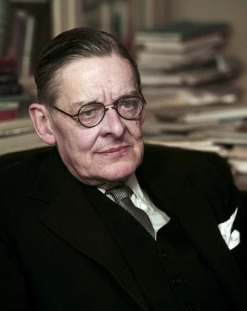Cacophony
a harsh, unpleasant combination of sounds or tones. It may be an unconscious flaw in the poet’s music, resulting in harshness of sound or difficulty of articulation, or it may be used consciously for effect, as Browning and Eliot often use it. See, for example, the following line from Browning’s “Rabbi Ben Ezra”:
Irks care the crop-full bird? Frets doubt the maw-crammed beast?
Sweeney Erect
T. S. Eliot
Paint me a cavernous waste shore
Cast in the unstilled Cyclades,
Paint me the bold anfractuous rocks
Faced by the snarled and yelping seas.
Display me Aeolus above
Reviewing the insurgent gales
Which tangle Ariadne’s hair
And swell with haste the perjured sails.
Morning stirs the feet and hands
(Nausicaa and Polypheme).
Gesture of orang-outang
Rises from the sheets in steam.
This withered root of knots of hair
Slitted below and gashed with eyes,
This oval O cropped out with teeth:
The sickle motion from the thighs
Jackknifes upward at the knees
Then straightens out from heel to hip
Pushing the framework of the bed
And clawing at the pillow slip.
Sweeney addressed full length to shave
Broadbottomed, pink from nape to base,
Knows the female temperament
And wipes the suds around his face.
(The lengthened shadow of a man
Is history, said Emerson
Who had not seen the silhouette
Of Sweeney straddled in the sun.)
Tests the razor on his leg
Waiting until the shriek subsides.
The epileptic on the bed
Curves backward, clutching at her sides.
The ladies of the corridor
Find themselves involved, disgraced,
Call witness to their principles
And deprecate the lack of taste
Observing that hysteria
Might easily be misunderstood;
Mrs. Turner intimates
It does the house no sort of good.
But Doris, towelled from the bath,
Enters padding on broad feet,
Bringing sal volatile
And a glass of brandy neat.
T.S. Eliot’s poem “Sweeney Erect” was written about Sweeney Todd, the demon barber of Fleet Street. The use of cacophony in this poem emphasizes the disturbing appearance of Mr. Todd, “Sweeney addressed full length to shave, broadbottomed, pink from nape to base.” Sweeney Todd is one of the earliest examples of a serial killer; by using a straight razor as his weapon he is able to cut the throats of his victims when they come to his barber shop for a shave. T.S. Eliot uses his schema of Sweeney Todd to create a somber atmosphere for the setting of his poem, and the use of cacophony adds to the unsettling feeling the reader feels while reading the poem.

"If you aren't in over your head, how do you know how tall you are?" ~T. S. Eliot
T. S. Eliot

Thomas Stearns Eliot was born in Missouri on September 26, 1888. He lived in St. Louis during the first eighteen years of his life and attended Harvard University. In 1910, he left the United States for the Sorbonne, having earned both undergraduate and masters degrees and having contributed several poems to the Harvard Advocate. After a year in Paris, he returned to Harvard to pursue a doctorate in philosophy, but returned to Europe and settled in England in 1914. The following year, he married Vivienne Haigh-Wood and began working in London, first as a teacher, and later for Lloyd's Bank.
It was in London that Eliot came under the influence of his contemporary Ezra Pound, who recognized his poetic genius at once, and assisted in the publication of his work in a number of magazines, most notably "The Love Song of J. Alfred Prufrock" in Poetry in 1915. His first book of poems, Prufrock and Other Observations, was published in 1917, and immediately established him as a leading poet of the avant-garde. With the publication of The Waste Land in 1922, now considered by many to be the single most influential poetic work of the twentieth century, Eliot's reputation began to grow to nearly mythic proportions; by 1930, and for the next thirty years, he was the most dominant figure in poetry and literary criticism in the English-speaking world.
As a poet, he transmuted his affinity for the English metaphysical poets of the 17th century (most notably John Donne) and the 19th century French symbolist poets (including Baudelaire and Laforgue) into radical innovations in poetic technique and subject matter. His poems in many respects articulated the disillusionment of a younger post-World-War-I generation with the values and conventions—both literary and social—of the Victorian era. As a critic also, he had an enormous impact on contemporary literary taste, propounding views that, after his conversion to orthodox Christianity in the late thirties, were increasingly based in social and religious conservatism. His major later poems include Ash Wednesday (1930) and Four Quartets (1943); his books of literary and social criticism include The Sacred Wood (1920), The Use of Poetry and the Use of Criticism (1933), After Strange Gods (1934), and Notes Towards the Definition of Culture (1940). Eliot was also an important playwright, whose verse dramas include Murder in the Cathedral, The Family Reunion, and The Cocktail Party.
He became a British citizen in 1927; long associated with the publishing house of Faber & Faber, he published many younger poets, and eventually became director of the firm. After a notoriously unhappy first marriage, Eliot separated from his first wife in 1933, and was remarried, to Valerie Fletcher, in 1956. T. S. Eliot received the Nobel Prize for Literature in 1948, and died in London in 1965.
(http://www.poets.org/poet.php/prmPID/18)
